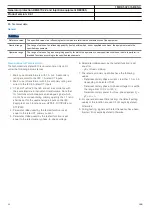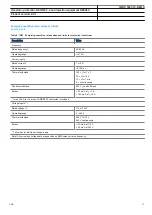
Reservation function QCRSV
M13506-3 v4
The purpose of the reservation function is primarily to transfer
interlocking information between IEDs in a safe way and to
prevent double operation in a bay, switchyard part, or
complete substation.
Reservation input RESIN
M16501-3 v5
The Reservation input (RESIN) function receives the
reservation information from other bays. The number of
instances is the same as the number of involved bays (up to
60 instances are available).
Bay control QCBAY
M13447-3 v8
The Bay control (QCBAY) function is used together with Local
remote and local remote control functions to handle the
selection of the operator place per bay. QCBAY also provides
blocking functions that can be distributed to different
apparatuses within the bay.
Proxy for signals from switching device via GOOSE
XLNPROXY
GUID-11F9CA1C-8E20-489B-822B-34DACC59553A v1
The proxy for signals from switching device via GOOSE
(XLNPROXY) gives an internal representation of the position
status and control response for a switch modelled in a
breaker IED. This representation is identical to that of an
SXCBR or SXSWI function.
GOOSE function block to receive a switching device
GOOSEXLNRCV
GUID-5AC7DE11-CB95-4565-A8AE-FB23D59FD717 v1
The GOOSE XLN Receive component is used to collect
information from another device’s XCBR/XSWI logical node
sent over process bus via GOOSE. The GOOSE XLN Receive
component includes 12 different outputs (and their respective
channel valid bits) with defined names to ease the 61850
mapping of the GOOSE signals in the configuration process.
Local remote LOCREM/Local remote control LOCREMCTRL
M17086-3 v8
The signals from the local HMI or from an external local/
remote switch are connected via the function blocks
LOCREM and LOCREMCTRL to the Bay control QCBAY
function block. The parameter
ControlMode
in function block
LOCREM is set to choose if the switch signals are coming
from the local HMI or from an external hardware switch
connected via binary inputs.
Tap changer position reading TCMYLTC and TCLYLTC
GUID-188A182C-8DD2-4357-B4A2-7CC817850D0E v2
On-load tap-changer position can be monitored on-line. This
can be done by either using BCD coded binary input signals
or alternatively via an mA input signal. The actual tap-position
can be used by the transformer or overall differential
protection function in order to enable more sensitive pickup
setting. This will in turn make differential protection more
sensitive for low level internal faults such as winding turn-to-
turn faults.
Logic rotating switch for function selection and LHMI
presentation SLGAPC
SEMOD114908-4 v10
The logic rotating switch for function selection and LHMI
presentation (SLGAPC) (or the selector switch function block)
is used to get an enhanced selector switch functionality
compared to the one provided by a hardware selector switch.
Hardware selector switches are used extensively by utilities,
in order to have different functions operating on pre-set
values. Hardware switches are however sources for
maintenance issues, lower system reliability and an extended
purchase portfolio. The selector switch function eliminates all
these problems.
Selector mini switch VSGAPC
SEMOD158756-5 v9
The Selector mini switch (VSGAPC) function block is a
multipurpose function used for a variety of applications, as a
general purpose switch.
VSGAPC can be controlled from the menu, from a symbol on
the single line diagram (SLD) on the local HMI or from Binary
inputs
Generic communication function for Double Point indication
DPGAPC
SEMOD55850-5 v7
Generic communication function for Double Point indication
(DPGAPC) function block is used to send double point
position indications to other systems, equipment or functions
in the substation through IEC 61850-8-1 or other
communication protocols. It is especially intended to be used
in the interlocking station-wide logics.
Single point generic control 8 signals SPC8GAPC
SEMOD176462-4 v10
The Single point generic control 8 signals (SPC8GAPC)
function block is a collection of 8 single point commands that
can be used for direct commands for example reset of LEDs
or putting IED in "ChangeLock" state from remote. In this
way, simple commands can be sent directly to the IED
outputs, without confirmation. Confirmation (status) of the
result of the commands is supposed to be achieved by other
means, such as binary inputs and SPGAPC function blocks.
The commands can be pulsed or steady with a settable pulse
time.
Automation bits, command function for DNP3.0 AUTOBITS
SEMOD158591-5 v8
Automation bits function for DNP3 (AUTOBITS) is used within
PCM600 to get into the configuration of the commands
coming through the DNP3 protocol. The AUTOBITS function
plays the same role as functions GOOSEBINRCV (for IEC
61850) and MULTICMDRCV (for LON).
Single command, 16 signals
M12446-6 v5
The IEDs can receive commands either from a substation
automation system or from the local HMI. The command
function block has outputs that can be used, for example, to
control high voltage apparatuses or for other user defined
functionality.
1MRK 502 074-BEN A
Generator protection REG670 2.2 and Injection equipment REX060,
REX061, REX062
Product version: 2.2.1
32
ABB













































